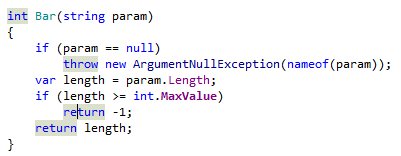Settings
In this page of ReSharper options, you can specify your preferences for code inspection.
Item | Description |
|---|---|
| General | |
| Enable code analysis | Select this checkbox to enable design-time code inspection. |
| Read settings from editorconfig and project settings | If you use EditorConfig to maintain code styles for your project, you can also configure code inspections from .editorconfig files. If this checkbox is enabled, you can configure code inspection severity levels right from .editorconfig files. |
| Color identifiers | This option lets you enable or disable ReSharper syntax highlighting scheme. If it is selected, language identifiers are highlighted with colors as defined in Visual Studio options: . The list of syntax identifiers provided by ReSharper is available in the Display items list, each name starting with ReSharper prefix. |
| Highlight color usages | Enables highlighting of color definitions in code. For more information, see Color Assistance. |
| Highlight special characters in string literals | Enables highlighting of correct and incorrect escape sequences in non-verbatim strings. For example: |
| Highlight context exits | This option, enabled by default, tells ReSharper to highlight all places where the control flow can exit the current context. For example, for a method, it will highlight the return type of the method, all |
| Enable solution-wide analysis | Enables solution-wide analysis (including solution-wide code inspections ), which is disabled by default. Note that in large solutions, solution-wide analysis may result in some performance degradation. However, there are several ways to improve the performance of the solution-wide analysis . |
| Include warnings | Enables warnings in the solution-wide analysis. When warnings are enabled in the solution-wide analysis, it works as follows: as long as there are errors in the solution, only errors will be displayed; unresolved warnings will only appear when the last error is fixed. When warnings are disabled, the status bar indicator will turn green as soon as the last error is fixed. |
| Show unused non-private type members when solution-wide analysis is off | When this option is enabled, ReSharper will detect all unused non-private members even if the solution-wide analysis is disabled. This option does not have any significant performance impact on small- and medium-sized solutions. |
| Show the 'Import namespace' action using popup | If this option is selected, a popup that suggests importing namespaces in C# and VB.NET shows up if there is one or more non-imported types are detected in the file:  |
| Value analysis mode | Using the value analysis, ReSharper finds out which entities can hold null value and highlights possible errors with null dereference. You can choose one of the following modes.
|
| Visual Studio Integration | |
| Do not show Visual Studio light bulb | This option is not available in Visual Studio versions older than 2015. |
| Merge Visual Studio light bulb actions into ReSharper bulb | If it is selected, ReSharper does the following for each Visual Studio's quick action:
|
| Suppress Visual Studio squiggles | This option is not available in Visual Studio versions older than 2015. |
| Projects to ignore | |
| The ignored projects will not be indexed by ReSharper, meaning that no ReSharper features — for example, code analysis, refactorings, code generation — will be available in those projects. This list is mainly intended to improve performance by not indexing and not analyzing projects that contain third-party code or frozen code, which is not going to be changed. Although the source files in the ignored projects are not parsed, ReSharper will still process the compiled code from the output of those projects (which is very cheap performance-wise). This means that after you build the ignored projects, ReSharper will correctly resolve usages of symbols from those projects and you will be able to enjoy navigate and search in those projects. So if after adding some projects to the ignore list, you have errors like 'Cannot resolve symbol', you need to build the ignored projects and ReSharper will be able to resolve those symbols from the compiled artifacts. To add projects to the ignore list, either use project file names, for example ProjectOne.csproj or file for examples, for example Project*.csproj to match ProjectOne.csproj, ProjectTwo.csproj, and so on. Note that the projects listed here will not be ignored when you run code inspection from the command line. | |
| Elements to skip | |
| ReSharper allows you to configure the list of files, file masks, and folders that should be excluded from code inspection. The excluded items are ignored by both design-time code inspection and code inspection in specific scope, but they are still indexed by ReSharper, so that you can navigate to or refactor symbols excluded from code inspection. | |

